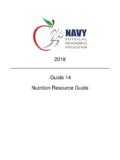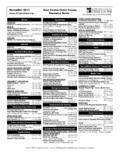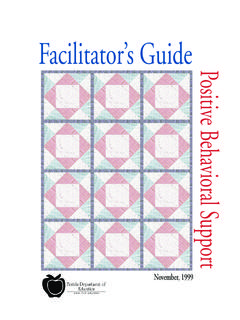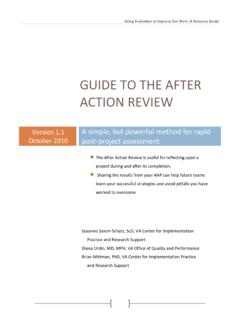Transcription of INTENTIONAL LEARNING ACTIVITIES - wrg3.org
1 Worldview and Cross-Cultur al Ministry Worldview resource Group 1 Worldview and Cross-Cultur al Ministry What are worldviews? Note to facilitator : Before starting the worldview course, situate the overall subject matter of the course within the framework of the five-stage strategy for holistic ministry. Remember that at the beginning of this course we only want to demonstrate the need to think about worldview. We are not trying to provide detailed or complex answers at this early stage. Rather, we want to: (a) introduce the subject of worldviews and (b) enhunger the participants to learn. In some training settings, we may need to provide a little background in basic cultural anthropology, one of the disciplines fro m which the subject of worldview is Introduction The following two stories illustrate two components of worldview: Note about facilitation: TELL / SHOW Use these or other short stories to illustrate the need to think about worldview.
2 Especially for concrete learners, support your stories with dr amat ic acting, photographs, props, and physical maps. a. Story: The death of Bawame in Papua New Guinea (see PPT slide) Worldview component: View of the nature of reality (the cause of sickness) God in His love sent missionaries to a remote part of Asia to proclaim the gospel of Christ. He led them to a village of the Bisorio people deep in the jungles of Papua New Guinea. The missionaries lived among the Bisorios, building loving relationships with them and LEARNING their culture and language. They did these things first in order to be able to clearly share the Good News! During the days of culture and language LEARNING , a Bisorio woman named Bawame was carried from a mountain location down to the village where the missionaries lived. She was thin and very weak.
3 The hearts of the missionaries broke with sadness and concern. After consulting medical workers, they prayed and cared for her, treating her with anti-malarial medicine and providing food and fresh water. Bawame s family allowed her and two relatives to stay in the missionaries home so they could provide her with the constant care she required. Praise God, she began to improve. The missionaries took hope in that she was go ing to recover. Then, unbeknownst to the missionaries, her uncle, Asebe, came and took Bawame away into the jungle to offer sacrifices to the ancestors to affect her healing. He took her in hopes that her illness was not caused by the yama, the evil spirit of death, for which no offering could be made. The missionaries heard people in the village shouting, They re taking Bawame! 1 Basic cultural anthropology may include a definition of culture and a description of the inst itut ions of cultur e (means of production, economics, kinship systems, marriage, social organization, political organization, and religion).
4 Worldview and Cross-Cultur al Ministry Worldview resource Group 2 They re taking Bawame! The missionaries ran down to the edge of the river only to see the dugout canoes pulling away with Bawame. Though she had clearly begun to improve, she was still frail and required more care and medicine. The missionaries called out, pleading, Please, Asebe, please don t take Bawame yet. Please, wait. Please, let us help. Asebe did not look back. He just kept paddling upriver, deep into the jungle. Bawame died shortly thereafter in a lonely, remote place, without ever hearing the Gospe l of Christ. b. Story: Acid and an alligator in a swimming pool in FL Worldview component: View of mankind (race) A motel manager in the Southern USA was furious when he witnessed blacks swimming with whites in the motel swimming pool. You can t do that.
5 Get out! screamed motel manager, James Brock. They didn t listen to him. Brock came back with a container of hydrochloric acid. OK, he said, this is acid. Acid! If you don t get out, I ll pour it in the water. Again, they refused to comply. So he poured the dangerous liquid into the pool (see PPT slide). The next day, Brock put an alligator in the pool to discourage the activists from coming back and continuing their mixed swimming in his pool (From Civil Rights Chronicle: The African America Struggle for Freedom by Clayborne Carson, 2003, p. 264). Note to facilitator : Having heard the differences in the way people view life, we now want to explore what is underneath the observable behavior that is observed. The goal of this discussion is to go deeper, but comments will st ill be general rather than specific.
6 Note about facilitation: REFLECT Ask the participants to reflect on the two stories. Lead a large group discussion about what is underneath the observable behavior of Asebei and the hotel manager. Have the group briefly reflect on what happened in each cultural situation. What were some of the tacit assumptions each person may have held? Record their feedback on the mark n wipe board. 2. What is underneath the observable behavior? a. View of the nature of realit y (the cause of sickness) from the perspective of Asebei versus the perspective of the missionaries b. View of mankind (race) fro m the perspective of the hotel manager Note to facilitator : At this early stage of the course, introduce a simple definition for the term worldview. Later in the course the definition will be expanded. No single definition or description captures all aspects of the concept.
7 Note about facilitation: TELL State definit io n and compare to Matthew 6:19-34 (note 22-23). Worldview and Cross-Cultur al Ministry Worldview resource Group 3 WORLDVIEW The lens through which one sees life VALUES Ideals born out of a worldview SOCIO-CULTURAL SYSTEMS AND INSTITUTIONS Marriage, family, religion, law, media, education, politics, and economics OBSERVABLE BEHAVIOR Symbols, speech, emotions, rituals, and actions 3. A definit io n of the term worldview: The lens through which one sees life (see PPT slide).2 Note to facilitator : We will now introduce a simple model that illustrates worldview and its associated outcomes. Graphics always have limitations and cannot express the subtle nuances or the complexit y of reality. Therefore, the concentric circles are not meant to infer watertight compart ments of life wit h boundaries that cannot be crossed.
8 Note about facilitation: SHOW Either use the PPT slide or draw the figure on the board and compare to Ephesians 4:17-24 and Isaiah 44:9-20. 4. A model of the concept of worldview a tool for analysis (see PPT slide) Source: Adapted from G. Linwood Barney in Hesselgrave, 1994, p. 49 2 See Appe ndix A for more definitions and descriptions of the term worldview. Worldview and Cross-Cultur al Ministry Worldview resource Group 4 WORLDVIEW VALUES Note to facilitator : We will now analyze the key components of the worldview model, represented by the concentric circles. Take your time in this analysis. Clearly explain each component, supporting your analysis with illustrations from diverse cultures. Keep things simple. Do not try to explain everything.
9 The difference between this section and the preceding section is simply that section 5 will separate the model into its component parts and will provide illustrations for each part. New content is not necessarily being added. Note about facilitation: TELL / SHOW Use the PPT slides or draw the concentric circles on the board; isolate the four concentric circles; explain what each represents in greater depth and illustrate the descriptions. 5. An analysis of the worldview model the four concentric circles a. Worldview the starting po int (see PPT slide) A worldview contains core assumptions about the nature of reality, including who man is and how he sees himself relating to every aspect of life. These core assumptions are part of a network of interconnected assumptions primarily derived from stories that form the lens through which one sees life.
10 For example: 1) The secular western worldview can be called materialistic evolution. It assumes an impersonal beginning (big bang) and that man and non-man evolved through rando m chance (natural selection). Physical death ends all. 2) The Bisorio worldview, which is animistic, assumes that the sun (a being) was the creator. Mankind, nature, spirit beings, and impersonal forces are all interconnected. Death is onl y a transition to another aspect of reality (similar to reincarnation). b. Values emerge fro m worldview assumpt ions (see PPT slide) Values are born out of one s worldview. They are expressions of ideals, that is, the way things ought to be in light of the accepted view of reality. For example: 1) In secular western values, man, having evolved, perceives himself to be autonomous. Personal choice is important.







